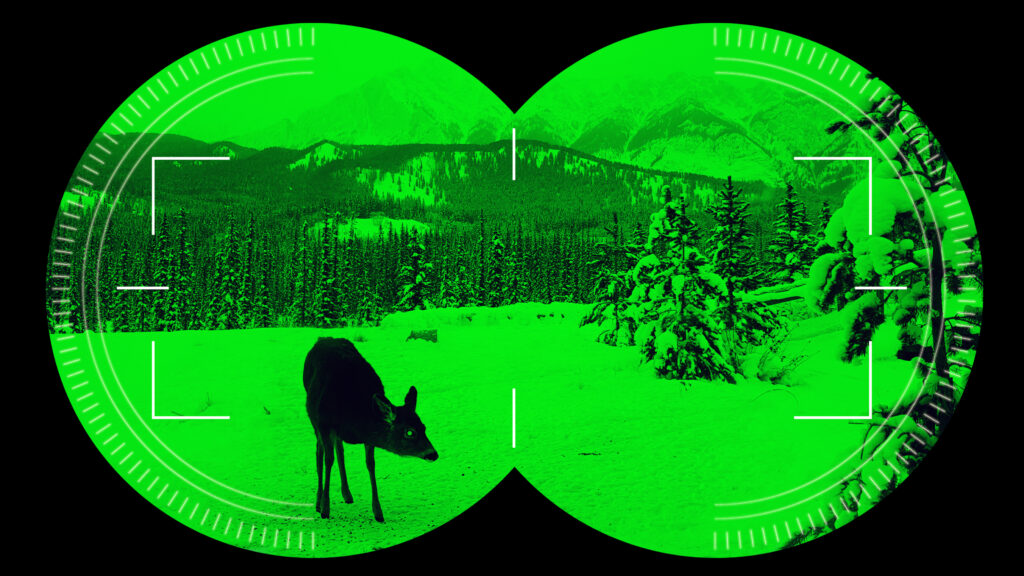When you stop and think about it, are cool bits of kit. Compact and convenient, they enable you to bring distant objects into focus, enhancing any backcountry adventure. The ability to closely study animals in their natural habitats make them an essential for wildlife enthusiasts.
What could be cooler than that? Well, night vision binoculars are undoubtedly the next level. Yep, there’s a Tim from Jurassic Park in all of us. Put night vision binoculars in front of us and we’re bound to get excited.
Whether you’re attempting to see if the Tyrannosaur has eaten the goat, or simply wanting to watch nocturnal animals do their thing, these advanced binoculars reveal the unseen world. But, how do night vision binoculars work? The work by collecting light, flipping the image around the right way and magnifying it for our pleasure. Our how do binoculars work guide focusses in on this more closely.
Here, we’re concerned with how night vision binoculars turn darkness on its head, utilising a blend of ingenious optics, science and electronics to deliver vampire bat-like sight in the dark. There are two different approaches: , the ghoulish green image we often associate with night vision, and , the visualisation of heat sources that you’re probably familiar with from spy flicks. Let’s delve into each… Also known as , image enhancing optics rely on collecting whatever visible light is present in a given field of vision, as well as the lower portion of infrared, no matter how dim or dark it is.
However, in total darkness, there’s no visible light to collect, rendering image enhancement impossible. Fortunately, total darkness is fairly rare and image enhancing optics can amplify any tiny amounts of light that are present to provide an image. These kinds of optics are often called night-vision devices or NVDs.
They use an , to turn near darkness into something that’s much more visible. The tube requires a power source to supply the needed voltage, which is why night vision binoculars often require batteries. Here’s how it all works: After being captured by the binoculars’ objective lens, the light travels through a photocathode and is converted from photons (the tiny particles that light is made up of) into electrons (the electricity carrying subatomic particle found in all atoms).
A or ) is used, in conjunction with the high voltage, to multiply the electrons. This MCP is a clever little device that contains millions of fiber-optic channels, has metal on other side and is contained in a vacuum. As the electrons hit the electrodes, they are accelerated, causing thousands of other electrons to be released through the channels.
This process is called . Now at the far end of the image-intensifier tube, the amplified electrons collide with a , solid materials that emit light when exposed to an electron beam. Incredibly, the alignment of the electrons hitting the screen is the same as the alignment of the original photons collected by the objective lens, so the resulting image is exactly proportional.
The phosphors emit the green light that we’ve become so familiar with when considering this kind of night vision. This green image is viewed by the eye through an ocular lens, which gives the viewer the option of magnifying and focussing the image. Gamers and action movie buffs will be familiar with the concept of thermal imaging, even if they’ve never lifted a pair of night vision goggles to their eyes in real life.
Back in the day, I put virtual thermal imaging to excellent use while stealthily sneaking past adversaries in the Metal Gear Solid game series. But what is thermal imaging and how does it work in the actual real world? Thermal imaging devices collect the upper portion of the emitted infrared light and create an image from it. This is why people and animals or radiators and ovens – basically anything emitting heat – stand out when viewed in this way.
One of the main differences between image enhancement and thermal imaging is that the latter works in total darkness. Let’s start with a bit of science. Warm objects emit infrared light.
Infrared lies just beyond the red end of the electromagnetic spectrum, which is also just beyond what the human eye can see. However, just because we can’t see it, doesn’t mean it’s not there. In thermal imaging binoculars, a special lens focusses the emitted infrared light from the objects it’s pointed towards.
It then employs a of infrared detector elements to create a , which is basically an intricate temperature pattern. This pattern is then converted into electric impulses that are sent to a . Within the signal-processing unit is a chip that converts the impulses into data to be sent to the display.
Often, the image produced is in black and white, with the hotter objects appearing brighter than the cooler ones. However, some thermal binoculars have the option of color, which adds clarity to the overall image. .
From: advnture
URL: https://www.advnture.com/features/how-do-night-vision-binoculars-work
